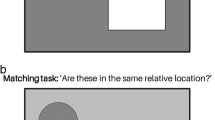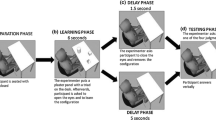Abstract
The cognition of spatial objects differs among people and is highly influenced by the context in which a spatial object is perceived. We investigated experimentally how humans perceive geometric figures in geometric proportional analogies and discovered that subjects perceive structures within the figures which are suitable for solving the analogy. Humans do not perceive the elements within a figure individually or separately, but cognize the figure as a structured whole. Furthermore, the perception of each figure in the series of analogous figures is influenced by the context of the whole analogy. A computational model which shall reflect human cognition of geometric figures must be flexible enough to adapt the representation of a geometric figure and produce a similarly structured representation as humans do while solving the analogy. Furthermore, it must be able to take into account the context, i.e. structures and transformations in other geometric figures in the analogy.
Preview
Unable to display preview. Download preview PDF.
Similar content being viewed by others
References
Dastani, M.: Languages of Perception. Institute of Logic, Language, and Computation (ILLC), Amsterdam, Universiteit van Amsterdam (1998)
Dastani, M.M., Indurkhya, B.: Modeling context effect in perceptual domains. In: Akman, V., Bouquet, P., Thomason, R.H., Young, R.A. (eds.) CONTEXT 2001. LNCS, vol. 2116, p. 129. Springer, Heidelberg (2001)
Dastani, M., Scha, R.: Languages for Gestalts of line patterns. Journal of Mathematical Psychology 47, 429–449 (2003)
Davies, C., Goel, A.K., Yaner, P.W.: Proteus: Visual analogy in problem solving. In: Knowledge-Based Systems (2008)
Evans, T.G.: A heuristic program to solve geometric analogy problems, Cambridge, MA, USA, Massachusetts Institute of Technology (1962)
Evans, T.G.: A program for the solution of a class of geometric-analogy intelligence-test questions. In: Minsky, M. (ed.) Semantic information processing, pp. 271–353. MIT Press, Cambridge (1969)
Forbus, K.D., Lockwood, K., Klenk, M., Tomai, E., Usher, J.: Open-domain sketch understanding: The nuSketch approach. In: AAAI Fall Symposium on Making Pen-based Interaction Intelligent and Natural, Washington, DC (2004)
French, R.M.: The computational model of analogy-making. Trends in Cognitive Sciences 6(5), 200–205 (2002)
Gust, H., Kühnberger, K.-U., Schmid, U.: Metaphors and heuristic-driven theory projection (HDTP). Theoretical Computer Science 354(1), 98–117 (2006)
Hofstadter, D.R., Mitchell, J.C.: The copycat project: A model of mental fluidity and analogy-making. In: Hofstadter, D.R., group, F.A.R. (eds.) Fluid Concepts and Creative Analogies, pp. 205–267. Basic Books, New York (1995)
Indurkhya, B.: Modes of analogy. In: Jantke, K.P. (ed.) AII 1989. LNCS, vol. 397. Springer, Heidelberg (1989)
Indurkhya, B.: Metaphor and cognition. Kluwer, Dordrecht (1992)
Koffka, K.: Principles of Gestalt Psychology. Harcourt, New York (1935)
Köhler, W.: Gestalt Psychology. Liveright, New York (1929)
Krumnack, U., Schwering, A., Gust, H., Kühnberger, K.-U.: Restricted higher-order anti-unification for analogy making. In: Orgun, M.A., Thornton, J. (eds.) AI 2007. LNCS, vol. 4830, pp. 273–282. Springer, Heidelberg (2007)
Mullally, E.-C., O’Donoghue, D., Bohan, A.J., Keane, M.T.: Geometric proportional analogies in topographic maps: Theory and application. In: 25th SGAI International Conference on Innovative Techniques and Applications of Artificial Intelligence, Cambridge, UK (2005)
Mullally, E.-C., Donoghue, D.P.: Spatial inference with geometric proportional analogies. Artificial Intelligence Review 26(1-2), 129–140 (2006)
O’Hara, S.: A model of the ”redescription” process in the context of geometric proportional analogy problems. In: Jantke, K.P. (ed.) AII 1992. LNCS, vol. 642. Springer, Heidelberg (1992)
O’Hara, S., Indurkhya, B.: Incorporating (re)-interpretation in case-based reasoning. In: Wess, S., Richter, M., Althoff, K.-D. (eds.) EWCBR 1993. LNCS, vol. 837. Springer, Heidelberg (1994)
Plotkin, G.D.: A note on inductive generalization. Machine Intelligence 5, 153–163 (1970)
Schwering, A., Krumnack, U., Kühnberger, K.-U., Gust, H.: Investigating Experimentally Problem Solving Strategies in Geometric Proportional Analogies, Osnabrueck, Germany, University of Osnabrueck, p. 233 (2008)
Schwering, A., Bauer, C., Dorceva, I., Gust, H., Krumnack, U., Kühnberger, K.-U.: The Impact of Gestalt Principles on Solving Geometric Analogies. In: 2nd International Analogy Conference (ANALOGY 2009). New Bulgarian University Press, Sofia (2009a)
Schwering, A., Gust, H., Kühnberger, K.-U., Krumnack, U.: Solving geometric proportional analogies with the analogy model HDTP. In: Annual Meeting of the Cognitive Science Society (CogSci 2009), Amsterdam, The Netherlands (2009b)
Schwering, A., Krumnack, U., Kühnberger, K.-U., Gust, H.: Syntactic principles of Heuristic-Driven Theory Projection. Special Issue on Analogies - Integrating Cognitive Abilities. Journal of Cognitive Systems Research 10(3), 251–269 (2009c)
Stollinski, R., Schwering, A., Kühnberger, K.-U., Krumnack, U.: Structural Alignment of Visual Stimuli Influences Human Object Categorization. In: 2nd International Analogy Conference (ANALOGY 2009). New Bulgarian University Press, Sofia (2009)
Wertheimer, M.: Experimentelle Studien über das Sehen von Bewegung. Zeitschrift für Psychologie 61, 161–265 (1912)
Author information
Authors and Affiliations
Editor information
Editors and Affiliations
Rights and permissions
Copyright information
© 2009 Springer-Verlag Berlin Heidelberg
About this paper
Cite this paper
Schwering, A., Kühnberger, KU., Krumnack, U., Gust, H. (2009). Spatial Cognition of Geometric Figures in the Context of Proportional Analogies. In: Hornsby, K.S., Claramunt, C., Denis, M., Ligozat, G. (eds) Spatial Information Theory. COSIT 2009. Lecture Notes in Computer Science, vol 5756. Springer, Berlin, Heidelberg. https://doi.org/10.1007/978-3-642-03832-7_2
Download citation
DOI: https://doi.org/10.1007/978-3-642-03832-7_2
Publisher Name: Springer, Berlin, Heidelberg
Print ISBN: 978-3-642-03831-0
Online ISBN: 978-3-642-03832-7
eBook Packages: Computer ScienceComputer Science (R0)




